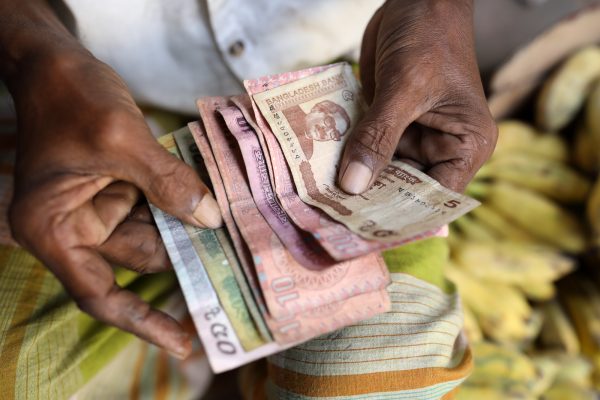
Bangladesh’s economy was one of the few to sustain a positive growth rate of 6.94 percent in 2021 during the COVID-19 pandemic. However, despite this, the structural weaknesses in different macroeconomic parameters can impair the nation’s continued progress. Today, Bangladesh faces the combined impact of declining global demand for its ready-made garments (RMG) exports, a collapse in remittances, rapidly falling foreign exchange reserves to stabilize the volatility of the Bangladeshi taka, concerns with the demand-supply gaps in the energy markets, and inflationary tendencies in the domestic economy. These difficulties caused Bangladesh to seek a precautionary International Monetary Fund (IMF) loan of $ 4.5 billion in July 2022.
The rising divergences in the government’s fiscal balance alongside the precarious Balance of Payments (BOP) situation in Bangladesh need urgent attention. Furthermore, while the country was doing well in various developmental parameters – like the Human Development Index (HDI) and the United Nations Sustainable Development Goals (SDG) – the exogenous shocks arising from the pandemic and the ongoing Russia-Ukraine war have exposed the country’s socio-economic vulnerabilities.
Bangladesh’s HDI value has seen a continuous rise due to an upward trend in indicators such as life expectancy, per capita Gross National Income (GNI), mean years of schooling, and expected years of schooling, which comprise the index. In the 2020 version of the HDI report, Bangladesh ranked 133rd out of 189 countries (with a score of 0.655 out of 1), while in the recently published HDI report for 2022, it improved to a rank of 129th out of 191 countries (a score of 0.661). That placed Bangladesh ahead of several South Asian countries such as India (132), Nepal (143), Pakistan (161), and Afghanistan (180).
While the country has found itself in the “Medium Human Development” group, the problem of income inequality looms large, despite falling poverty levels over the years. Income inequality has historically been a menace in Bangladesh, even amid its commendable performance on most other socio-economic indicators. The country’s Gini coefficient (a measure of economic inequality) rose from 0.456 in 2010 to 0.482 in 2016.
Bangladesh has shown a very unusual stagnation in both income and wealth inequality in the last few decades. Between 1995 and 2021, the percentage share in the pre-tax national income of the bottom 50 percent of the adult population has moved only from 16.25 percent to 17.08 percent, while these values for the top 10 percent of the adult population shifted from 44.88 percent to 42.40 percent. During the same period, the percentage share in the total net personal wealth of the bottom 50 percent of the adult population changed only from 4.69 percent to 4.77 percent, and went from 59.2 percent to 58.7 percent for the top 10 percent of the adult population.
On the one hand, this relative stagnancy denotes that the income inequality situation has not substantially worsened; on the other hand, it implies that income inequality has not translated to any rising trend in wealth inequality. The latter could, however, be caused by the diversion of income into the consumption stream, compromising on savings that could enable medium- to long-term investments and capital formation in the economy.
Bangladesh’s economy is indeed characterized by a falling trend in gross savings in the last decade – from 35.9 percent of Gross National Income (GNI) in 2010 to 33.9 percent of GNI in 2020. This has two major implications. First, as savings induce investments, especially for developing nations, a declining trend in the former dampens asset creation, domestic production, and employment – thus deteriorating the growth pattern in the economy. Second, if household savings are not adequately channeled into infrastructure building, primarily through government infrastructure projects, it adds to the fiscal burden induced by unsustainable infrastructure expenditure that Bangladesh’s government is already suffering from.
In terms of the continuity of the development trends in Bangladesh, further reducing inequality should be the key focus to make the growth process more inclusive – in tandem with the U.N. Sustainable Development Goals (SDG) Agenda 2030 to “leave no one behind.”
Bangladesh has slowly but consistently risen in its overall SDG score from 59.37 (out of 100) in 2016 to 64.22 in 2022, good for a rank of 104 out of 163 nations. However, its performance in the East and South Asia region remains considerably low – ranking 14 out of 19 countries in the region, ahead of only Pakistan, India, Laos, Mongolia, and Cambodia. Other significant challenges to sustainable development in Bangladesh include the integration of coastal communities in the government’s national plans, illicit financial flows and insufficient resource mobilization, and building more democratic institutions to achieve the SDGs.
Interestingly, Bangladesh’s progress on various socio-economic indicators is enabled by the extensive presence of small and large-scale non-government organizations (NGOs), which have led to improved access to essential services such as sanitation and water supply at village levels. This model has also led to more women’s participation in public spaces and households – translating into notable improvements in children’s health and education and average life expectancy. This has undoubtedly led to advancements in various sustainable development objectives such as SDG 3 (Good Health and Well-being), SDG 4 (Quality Education), SDG 5 (Gender Equality), and SDG 6 (Clean Water and Sanitation), among others.
In conclusion, Bangladesh follows a somewhat unique model of development. Traditionally, there is moderately unidirectional developmental pattern, where the institutions in the Global North design the implementation strategies, which are then executed through the local partners. However, Bangladesh’s approach is characterized by the significant role played by domestic microfinance institutions like Grameen and international development organizations like Bangladesh Rural Advancement Committee (BRAC). These organizations take ownership of the design, finance, and scale in tandem with local requirements and solutions, leading to more concrete results in the longer horizon.
Bangladesh will need to continue to harness this unique advantage amid the difficult economic conditions ahead.
A Looming Economic Crisis in Bangladesh
Source: Frappler

0 Comments